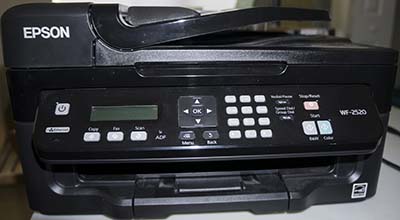Epson WorkForce WF-2520 — wireless all-in-one inkjet printer — a review
© 2019 Peter Free
07 March 2018 (updated 15 April 2019)

Update — the glee of intentional destruction
Today, I bounced the Epson WF-2520 off the floor and happily watched it disintegrate into pieces.
I'll tell you why at the end of this review.
Epson WF-2520 inkjet — the second worst I have used
Despite my four year old vow not to buy another of Epson's in-your-face disaster printers, we wound up with this one — the WorkForce WF-2520 — obtained while based in Germany three years ago.
Our choices had been limited to the 2520, due to the lack of availability of competing dual voltage models.
Three years later, the 2520 has demonstrated itself to be just as much of an abomination as its Artisan 835 predecessor.
Story short
In addition to the time-wasting software and control panel irritations that were incorporated into the previous Artisan 835 (see that review here), the 2520 followed its predecessor's habit of ink-clogging after a few weeks of non-use.
When this happens, one has to painstakingly navigate the printer's obtuse control panel, and its equally obtuse menu, to the "maintenance" section. That's unhelpfully located way too many button pushes into the menu. Especially so, considering how often one has to clean the printer's jets.
The cleaning process itself takes a long time. It noticeably wastes ink and paper. I usually have to clean the jets twice, before the printer starts printing properly.
The only good thing
The WF-2520 prints the occasional digital photograph with reasonable quality, even without assistance from Adobe's Photoshop.
That's a marked improvement over most of the other inkjet printers that I have used. Most of those have had trouble even getting a color approximation of what they are supposed to be rendering, even with Photoshop's assistance.
But on the negative side — also with regard to photo printing
A spatially confused someone wrote Epson's guide to photo paper orientation and layout. Knowing how to orient photo paper and digital photograph on the Epson printer is unnecessarily confusing. The manual's diagrams and text do not accord with the printer's actual doings. Nor does the Epson software driver integrate perfectly with my iMac or Photoshop.
Getting the printer to print properly laid out portraits and landscapes requires seeing what comes out and then adjusting the paper to that result, contrary to Epson's instruction manual.
More annoying is the printer's insistence that a photo is too big for the paper (margins or no margins), when it is (according to Photoshop and the iMac) obviously not.
Incidentally
Our sample of the WF-2520 would not print dual-sided copies of anything. Despite the fact that it was supposed to, and no matter how much fiddling with its interface I did.
A metaphorical coup de grace
While disconnecting the USB cable from the back of the Epson today, the 2520's flimsy paper holder fell off. As if to say it was done doing its job.
I noticed that Epson's instruction manual does not tell users how to reattach the holder. Epson's diagrams are drawn from a perspective that obstructs seeing the proper location for the holder's plastic pins. Evidently, Epson thinks that nothing ever goes wrong with its gizmos.
Recognizing that the manufacturer had relied on plastic's mild flexibility as a design component, I mashed the paper holder back into "where I thought it should go" place. That worked.
But still, wouldn't you expect a manufacturer to anticipate that its ineptly designed paper holder might fall off?
In sum — the WF-2520 is the second worst inkjet that I have used
The worst was Epson's Artisan 835. For the same reasons.
And today's not-so-sad end
If reading the above review is not enough to dissuade you from spending money on a low-end Epson printer, consider today's events.
A year ago, I substituted a Brother MFC-J650DW for the Epson. The WF-2520 had clogged its jets again and did not have enough ink left to clean them.
Today, due to the fact that the Brother only prints atrocious photos, I reconnected the Epson with fresh ink.
Sadly, it did not recognize the network that it had been on last year. Which meant that there was no way to talk to it from my computer.
Nor, apparently, did it recognize its own Epson driver And Epson.com's updated driver evidently did not alert my iMac enough to recognize it and bring the WF-2520's name up on the iMac's list of printers.
A reset to the printer's defaults didn't sort the mess.
In passing, I noticed that the WF-2520's user panel was insisting that 2019 is not the "correct" year.
Neither, the panel told me, was 2018 a correct year. I didn't go any further back. The printer had known who 2018 was, when I disconnected it last year. Evidently, during storage on a closet shelf, dementia had set in.
Hmmm.
The Epson's user panel offered no way to input the home network's name and password. And the lack of an appropriate USB cord prevented me from connecting the recalcitrant printer directly to my computer.
After a good bit of unsuccessful messing, I forcefully introduced the miserable machine to a hard reality welcome.
Did I feel childish?
Not at all.
The moral? — You can probably do better than these low-end Epson printers
How much better, I do not know.
The Brother MFC-J650DW that I mentioned above is not much more dependable.
Its saving grace is a touch screen that allows faster, much more intuitive menu access. And the J650's ink-related maintenance programming makes it easier to bring the printer back into operation, when something goes wrong.
On the negative side, the Brother's output is noticeably inferior to both of the Epsons that I have reviewed. At least so, on the few occasions that the Epsons were in the mood to print anything.
 PeteFree.com
PeteFree.com